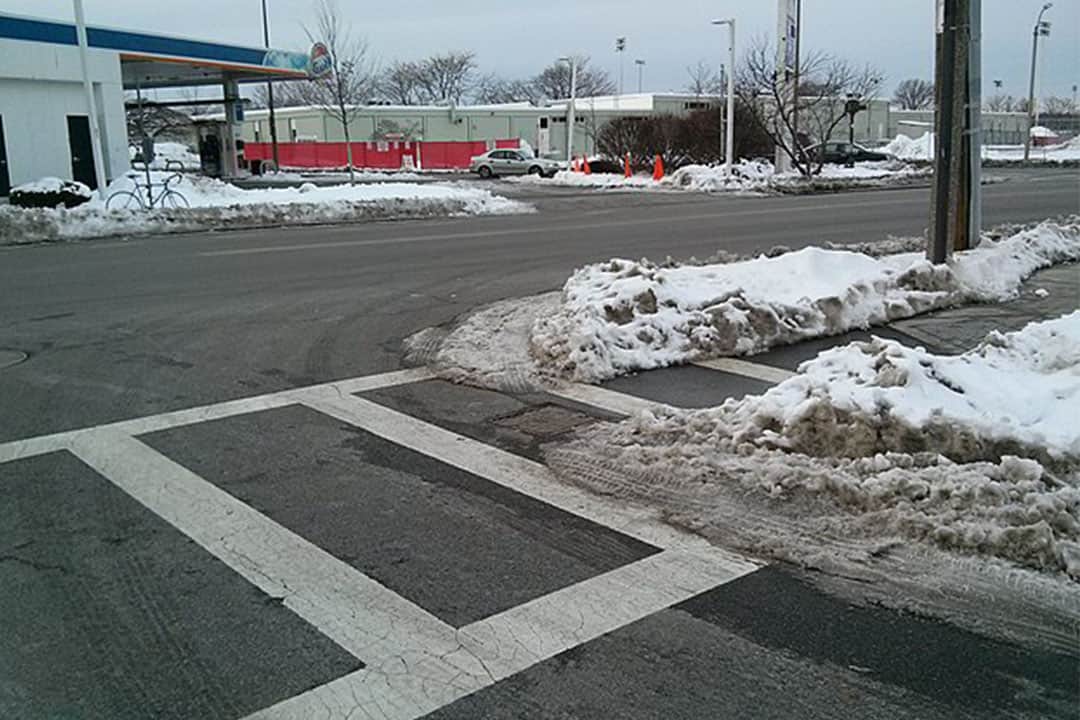As the cold winds begin to sweep through Toronto and bring with them inevitable snowfall, a unique phenomenon is unveiled on our city streets. Fallen snow reveals the true extent of our urban planning missteps in the form of the sneckdown.
Sneckdowns — born from the convergence of snow and streets — reveal the staggering amount of space we squander on roads, particularly for cars. They’re a wake-up call that I believe we can no longer ignore.
What is a ‘sneckdown’?
The sneckdown phenomenon, short for snowy neckdown, is a tangible representation of how we can potentially reconfigure urban spaces. Sneckdowns refer to the snowbanks accumulated on paved spaces where people don’t drive or park — typically sidewalk extensions or street islands designed to damper drivers. They highlight places where we should give precedence to human activity over vehicular transit.
With sneckdowns, I see an opportunity to redefine the contours of Toronto by reclaiming surplus road space for pedestrians.
Empirical evidence from cities that have implemented pedestrian-centric initiatives attests to the viability and efficacy of such urban planning endeavours. Notable examples in places that face similar winters include New York’s iconic Times Square and the Seine Riverbank in Paris. These urban locales have successfully executed pedestrian-oriented design principles, yielding benefits of enhanced livability and economic vitality.
Reducing winter accidents
Using sneckdowns, we can mark paths for walking and biking, which can help people see better in the snow. Studies have demonstrated that clear distinctions between cleared pathways and snow-covered areas serve as effective visual markers for pedestrians and cyclists, thereby reducing the likelihood of accidents.
Furthermore, incorporating reflective materials — such as reflective sheeting in pavement markings and signs — is a well-documented strategy to enhance visibility, particularly in low-light conditions. Research has also consistently shown that reflective surfaces significantly improve safety for pedestrians and cyclists, particularly during winter evenings when natural light levels are diminished.
Additionally, raised retroreflective pavement markers have been shown to enhance pedestrian safety. By implementing these principles into urban planning, I believe cities can create environments that offer clear visual guidance and ultimately reduce the likelihood of missteps or collisions — particularly in areas influenced by sneckdown patterns during challenging winter conditions.
A pedestrian’s paradise
Environments that prioritize pedestrians over cars contribute to improved mental well-being and social interaction. Spaces designed for leisurely strolls and outdoor activities foster a sense of community and social cohesion. Vibrant public spaces like outdoor cafés have been associated with increased social interaction and a sense of belonging.
Pedestrian-friendly environments also have economic benefits, as they lead to increased economic activity and business viability. When people have the opportunity to explore their surroundings on foot, they are more likely to patronize local businesses, contributing to positive economic impacts for the community.
Finally, prioritizing pedestrians over cars reduces negative environmental impact by minimizing reliance on personal vehicles, lowering emissions, decreasing traffic congestion, and mitigating a city’s overall carbon footprint. Overall, I see this vision of urban transformation through reclaiming excess road space to be substantiated by empirical evidence, offering a pathway to an inclusive, accessible, and sustainable urban future.
Safe, dedicated bike lanes
A 2020 study showed that physical separation between cyclists and motor vehicles in Toronto significantly decreased the risk of collisions. Bollards — the posts that are placed along roads to keep vehicles away — serve as an effective deterrent against vehicles encroaching into the bike lane, providing an added layer of safety.
Moreover, wider bike lanes — especially those situated away from parked cars or equipped with protective barriers — mitigate the risk of ‘dooring’ incidents, a significant hazard for cyclists. Research supports that broader cycling lanes with physical barriers substantially reduce such accidents.
Sneckdowns show where we can potentially expand bike lanes, which would lead to safer and more comfortable cycling environments. By incorporating elements of comfortability into urban planning, cities can create cycling infrastructure that not only promotes safety but also encourages active modes of transportation throughout the cold months.
Rediscovering community
Remember the outdoor patios that remained open throughout the winter during COVID-19? That sense of community does not need to go away! Plaza development and outdoor patios in urban environments contribute significantly to the overall quality of life for residents and visitors alike, and this is equally important in winter.
Engaging in outdoor activities and dining promotes positive social interactions and leads to improved mental well-being and a stronger sense of community. Additionally, plaza development and outdoor patios have been shown to stimulate local commerce and economic activity. When outdoor spaces are used for dining and entertainment, they create opportunities for extended periods of patronage, benefiting local businesses and the overall economy — as seen in New York where road closures to promote outdoor dining significantly benefited the city’s restaurants during the pandemic.
Sneckdowns visually demonstrate where we can repurpose excess road space into public areas, which can include plazas and outdoor patios. This not only enriches the urban experience but also contributes to economic vitality, especially for businesses reliant on foot traffic. Overall, I believe dedicating larger pedestrian commerce spaces aligns with evidence-based urban planning strategies focused on creating inclusive, accessible, and dynamic urban environments.
Real change: How do we get there?
By using these natural snow formations as blueprints for Toronto’s actual use of space, we can strategically reallocate excess road space to create wider sidewalks, protected cycling lanes, and vibrant outdoor spaces. This shift prioritizes pedestrians, cyclists, and public transit users, fostering a more inclusive and dynamic cityscape.
As we brace ourselves for the impending snowfall, let’s use the sneckdowns as a powerful reminder of the untapped potential beneath our tires. Toronto deserves a downtown core that thrives on the energy of its inhabitants, not the exhaust fumes of its vehicles.
Emily Carlucci is a third-year student at Trinity College studying political science and English. She is a Traffic Tango columnist for The Varsity’s Comment section.



No comments to display.